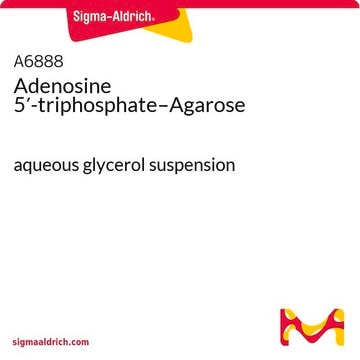This product is a conjugate of 5'-ATP to crosslinked 4% beaded agarose (activated by cyanogen bromide), via the C-8 atom of 5'-ATP. A 9-atom matrix spacer arm connects the ATP and the agarose. Please see the link below to review the product datasheet for more information:
https://www.sigmaaldrich.com/deepweb/assets/sigmaaldrich/product/documents/174/887/a2767pis.pdf
A2767
Adenosine 5′-triphosphate–Agarose
lyophilized powder
Sinónimos:
5′-ATP agarose
Seleccione un Tamaño
$169.00
Fecha estimada de envío15 de abril de 2025DesdeMILWAUKEE
Seleccione un Tamaño
About This Item
$169.00
Fecha estimada de envío15 de abril de 2025DesdeMILWAUKEE
Productos recomendados
origen biológico
plant (Sea weed)
Formulario
lyophilized powder
Extensión del etiquetado
1-5 μmol per mL
Matriz
cross-linked 4% beaded agarose
activación de la matriz
cyanogen bromide
unión a la matriz
C-8
espaciador de matriz
9 atoms
temp. de almacenamiento
−20°C
cadena SMILES
[X]Nc1ncnc2[n](cnc21)[C@@H]3O[C@@H]([C@H]([C@H]3O)O)CO[P](=O)(O[P](=O)(O[P](=O)(O)O)O)O
¿Está buscando productos similares? Visita Guía de comparación de productos
Categorías relacionadas
Descripción general
Aplicación
Forma física
Código de clase de almacenamiento
11 - Combustible Solids
Clase de riesgo para el agua (WGK)
WGK 3
Punto de inflamabilidad (°F)
Not applicable
Punto de inflamabilidad (°C)
Not applicable
Equipo de protección personal
Eyeshields, Gloves, type N95 (US)
Elija entre una de las versiones más recientes:
Certificados de análisis (COA)
¿No ve la versión correcta?
Si necesita una versión concreta, puede buscar un certificado específico por el número de lote.
¿Ya tiene este producto?
Encuentre la documentación para los productos que ha comprado recientemente en la Biblioteca de documentos.
Los clientes también vieron
-
Where is the linker attached on the ATP molecule
1 answer-
Helpful?
-
-
How can I hydrate Product A2767, Adenosine 5´-triphosphate-Agarose?
1 answer-
The resin can be hydrated by placing it in excess water, approximately 50 mL per g of resin, for at least 30 minutes. Remove the lactose stabilizer by washing the resin on a Buchner funnel with gentle vacuum, using approximately 100 mL of water per g of resin. Do not allow the resin to dry. Resuspend the resin in excess water or starting buffer to pack the column bed.
Helpful?
-
-
How can I regenerate Product A2767, Adenosine 5´-triphosphate-Agarose?
1 answer-
Since N6-[N-(6-aminohexyl)-carbamyl]-ADP is a substrate for acetate kinase and pyruvate kinase, these enzymes can be used to regenerate ATP from ADP on the resin under conditions favoring the reverse reaction. Wash the resin with 20 volumes of 50 mM Tris HCl buffer (pH 8.2), with 0.2 mM EDTA and 100 mM KCl. Incubate the resin overnight at 2-8°C in an ATP-regenerating mixture containing 0.2 mM phosphoenol pyruvate, pyruvate kinase (10 units per mL of resin), 5 mM MgCl2, 0.2 mM EDTA and 100 mM KCl in 50 mM Tris HCl buffer (pH 8.2). Wash the resin with 25 column volumes of 2 mM ATP in 2 M KCl and reequilibrate the resin with 25 column volumes of sample buffer. Alternatively, the ATP regenerating mixture can contain 20 mM acetyl phosphate, acetate kinase (6.8 units per mL of resin), and 3 mM MgCl2 in 100 mM Tris HCl (pH 7.6). If acetate kinase is used, prewash the resin with 25 column volumes of 100 mM Tris HCl (pH 7.6), but use the same final wash and reequilibration steps as given for pyruvate kinase.
Helpful?
-
-
What is the Department of Transportation shipping information for this product?
1 answer-
Transportation information can be found in Section 14 of the product's (M)SDS.To access the shipping information for this material, use the link on the product detail page for the product.
Helpful?
-
-
How can I elute my proteins from Product A2767, Adenosine 5´-triphosphate-Agarose?
1 answer-
Specifically bound proteins can be eluted with 10-100 mM ATP or ADP. Nonspecifically bound proteins can be eluted with 2 M NaCl or KCl in water or 7 M urea.
Helpful?
-
-
Can I store Product A2767, Adenosine 5´-triphosphate-Agarose, after I have hydrated it?
1 answer-
For the short term, it is possible to store the hydrated resin in 20% ethanol and dilute buffer at 2-8°C. In general, the hydrated resin can be stored refrigerated in water or buffer containing a bacteriostat, such as 0.02% sodium azide or thimerosal. Do not autoclave or freeze the hydrated resin. The resin can be used several times without loss of effectiveness. However, the ATP will slowly hydrolyze to ADP over time, and under certain conditions this process may be accelerated during usage. The resin can be regenerated; please see the regeneration FAQ for this product.
Helpful?
-
Active Filters
Nuestro equipo de científicos tiene experiencia en todas las áreas de investigación: Ciencias de la vida, Ciencia de los materiales, Síntesis química, Cromatografía, Analítica y muchas otras.
Póngase en contacto con el Servicio técnico





